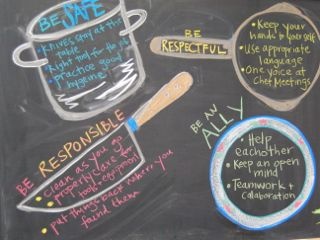Kitchen Humanities: Kitchen Orientation

Summary
This lesson introduces 6th grade students to the kitchen classroom. Students meet staff, tour the kitchen, and learn the basic rules and systems. They then write and share a food memory.
Objectives
After this lesson, students will be able to:
- Name the basic tools and equipment in the kitchen
- Use descriptive language and sensory details in a short essay
- Practice implementing basic kitchen routines
Assessments
During this lesson, students will:
- Accurately identify the basic tools and equipment in the kitchen
- Write a descriptive food memory
- Compost foods scraps and correctly utilize the bussing system
Materials
- Toolbox
- Food memory worksheet
- Pencils
- Seasonal fruits or vegetables
Before You Begin
- Copy the Food Memory worksheet to hand out
- Prepare a seasonal garden snack
- Create the visual aid
Procedures
Welcome and Introduction
- Welcome students, and divide them into three table groups. Table groups are color-coded: green, red, and blue.
- Introduce kitchen staff and volunteers.
- Emphasize the students’ transition from the garden to the kitchen, and invite them to share examples of plants they saw growing in the garden throughout the fall.
- Have students define organic and seasonal. Discuss what is cooked in the kitchen (organic, seasonal, vegetarian).
- Discuss the behavior expectations in the kitchen.
- Give a general tour of important kitchen features and systems: cubbies, recycling, compost, spice table, oven, dish cupboard, altar, metro shelf, fridge, bussing station, griddle, dish tower, and dishwasher.
- Answer questions and direct students’ attention to their table group.
Table Group Tour
- Explain to the table groups their areas of responsibility: the table, the toolbox, and the cooking station. Address that students are responsible for cleaning and maintaining these three areas.
- Familiarize students with the cooking station and its contents, asking them to name the basic tools and equipment throughout the tour.
- Familiarize students with the toolbox and its contents (toolboxes are color-coded for each table).
- Explain the knife rules in the kitchen and ask students to demonstrate proper knife safety.
Food Memory
- Pass out the Food Memory worksheets and pencils.
- Read several examples and ask students to describe a personal memory about food using vivid language. Encourage students to think about the setting, the flavors, the aromas, and other details such as the time of year and the occasion.
- Provide water and a seasonal snack.
- Have students familiarize themselves with the kitchen systems by composting, bussing dishes, and refilling water pitchers.
At the Closing Circle
- Invite students to share their food memories.
- Answer any remaining questions.
Vocabulary
Seasonal
Organic
Cubbies
Dish Cupboard
Altar
Metro Shelf
Fridge
Bussing Station
Griddle
Dish Tower
Spice Table